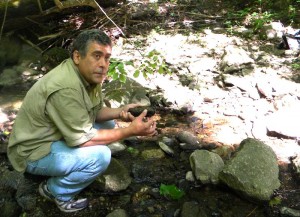11
Environmentalist: Bay Faces ‘Death by a Thousand Cuts’

Environmentalist Tom Schueler describes the health of this small stream near Ellicott City, Md. (News21 Photo by Daniela Feldman)
ELLICOTT CITY, Md. – The Chesapeake Bay faces “death by a thousand cuts” unless regulators can reduce the amount of nutrients, metals and other pollutants carried into its rivers by stormwater, said environmental activist Tom Schueler.
Stormwater is the fastest-growing source of pollution in the Chesapeake Bay.
“The last three decades of steady suburban and exurban growth has greatly increased the amount of land that’s been paved over or the amount of turf cover that goes with it,” said Schueler, coordinator of the Chesapeake Stormwater Network, an environmental advocacy group.
Development in the Chesapeake Bay watershed – more roads, roofs and driveways – all prevent rainwater from being absorbed into the soil. Increasing amounts of pollutants flow off these developed lands and into streams and creeks.
Schueler said nutrients, trace metals, oil and grease are some of the pollutants carried in runoff.
He said tougher standards for new development – to reduce sediment and pollutant runoff – need to be put in place, and enforcement of industrial permits needs to be stepped up to prevent pollutants from coming into contact with rainwater.
He added, “If we don’t get serious in the bay watershed to have tougher standards, more enforcement, more frequent inspections and greater accountability, we’ll lose this resource.”
–By Allison Frick
About Us
Our Stories
- Md. Officials May Temporarily Lift Ban on Female Crab Harvest in Bay
- Scientists, Environmentalists Question Readiness of Chesapeake Bay Disaster Plans
- Inner Harbor Water: Unsafe Bacteria Levels, Test Shows
- Swimmers’ Impressions of Bay Not Always in Sync With Its Health, Scientists Say
- Chesapeake Bay Swim Attracts Hundreds in Balmy Conditions, But Course Includes ‘Dead Zone’















